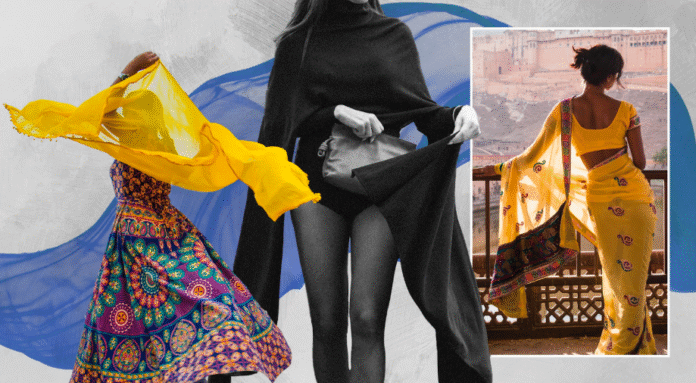By Manha Masood
In recent years, the global fashion industry has increasingly been embracing cultural diversity on a surface level. Western brands and influencers often rename traditional non-Western garments under new labels, stripping them of their cultural significance and origin. An up-and-coming example is the South Asian dupatta being rebranded as a “Scandinavian shawl” or “boho wrap,” turning a centuries old symbol of identity into a fashion trend detached from its roots.
The dupatta is more than a simple piece of cloth. In South Asian culture, it serves a variety of purposes: modesty, elegance, religious significance, and familial tradition. It is worn during celebrations, religious rituals, and daily life, often with deep personal and cultural meaning. Each region in South Asia offers its own take on the garment, from the phulkari embroidery of Punjab to the bandhani dye of Gujarat.
Yet, when the same item appears on a Western runway or a fast fashion website such as Oh Polly or Peppermayo, it’s often labeled in ways that erase its heritage and its significance to the culture. A handcrafted dupatta becomes a “lightweight festival shawl,” marketed as a chic accessory for summer evenings. The original artisans, mostly women from rural South Asian communities, are rarely credited, and the cultural context is sidelined in favor of an aesthetic that fits into minimalist Western branding.
This isn’t appreciation; it’s appropriation. When culture is exploited for profit without proper acknowledgment, it becomes a one-sided transaction. The original creators and cultures are excluded from the narrative while other Western big-budget companies profit from the trends. The irony is hard to ignore, what was once considered “ethnic” by Western audiences is now fashionable, only after being stripped of its cultural context.
This rebranding also highlights a broader pattern. The desire to consume culture without engaging with its history or meaning. It’s easier to sell a “Scandinavian shawl” than to explain what a dupatta is and where it comes from. But this ease comes at the cost of dismissing the identity, authenticity, and respect of many minority groups.
The solution isn’t to gatekeep culture, but to share it sustainably. Fashion can absolutely be a space for cultural exchange, but it requires transparency, credit, and general knowledge. A simple label change from “shawl” back to dupatta, along with stories of its origins, can make a big difference.
Ultimately, recognizing the dupatta as more than fabric or fast fashion helps us respect the people and traditions behind it. Let’s move from shallow trend cycles to meaningful appreciation – where cultural garments aren’t rebranded, but respected.

